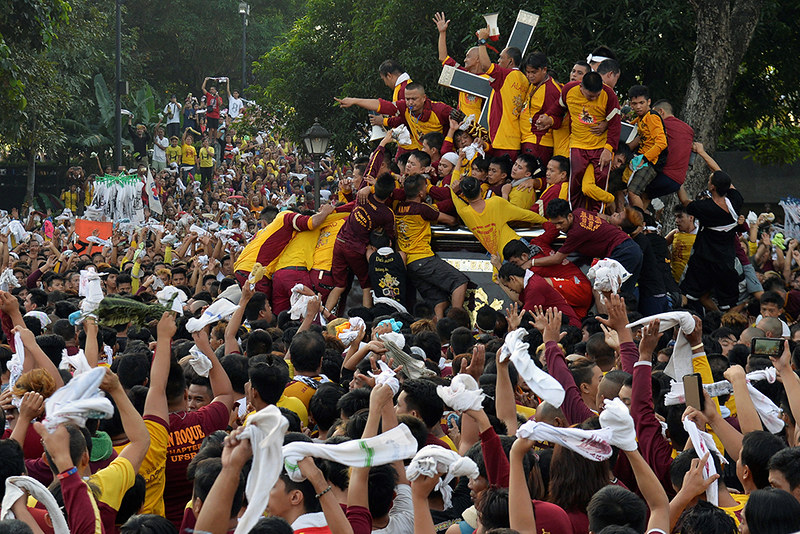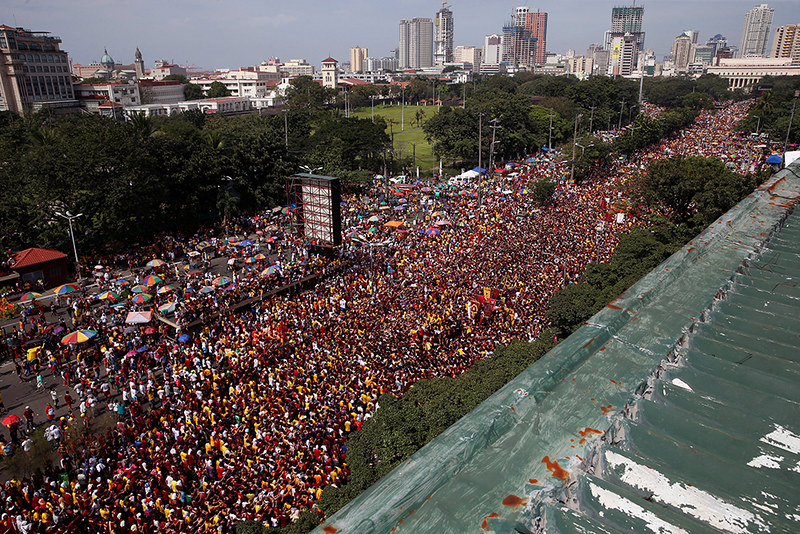Black Nazarene Procession
A Sea of Barefoot Prayer and Faith Filling Manila
2026/01/08
Every January 9, the city of Manila is transformed into a river of faith during the Black Nazarene Procession. As one of the world’s largest religious events, millions of devotees walk barefoot for nearly 24 hours, carrying the life-sized image of Christ bearing the cross—the Black Nazarene—through the city. People of all ages join this intense and prayerful procession, seeking miracles, healing, and the fulfillment of their wishes. For pilgrims and tourists alike, it is an overwhelming moment to experience the “living faith” of Filipino Catholicism with all five senses.
The procession takes place every January 9, starting at Quirino Grandstand and ending at Quiapo Church. Not only devout Catholics, but also families, the sick, and those filled with gratitude join, each carrying their own prayers in their hearts.
Main Attractions
The Traslacion (Grand Procession)
The heart of the event is the “Traslacion,” a grand procession covering about 6.5 kilometers. Barefoot devotees, dressed in maroon and yellow, push and pull the carriage (andas) carrying the Black Nazarene statue. Many try to touch the statue or throw handkerchiefs and towels to be wiped on it, hoping for blessings or healing. The chant “Viva Señor Nazareno!” and hymns echo through the crowd, mingling with heat, sweat, and emotion.
Key Events
The day begins with a pre-dawn Mass, followed by the departure from Quirino Grandstand. Many participants walk barefoot for hours, some weeping, others singing or shouting prayers as they go. The “Dungaw” moment, when the Black Nazarene meets the image of the Virgin Mary at San Sebastian Church, is especially moving. There are also overnight vigils, multiple Masses, and a final ceremony at Quiapo Church.
Costumes and Decorations
Most devotees wear maroon and yellow shirts, the symbolic colors of the Black Nazarene, often printed with the image or logo. Many carry white handkerchiefs or towels, hoping to have them touched to the statue. The andas (carriage) is decorated with flowers and candles, while banners and streamers line the route. The scent of incense, sweat, and street food mix in the air, adding to the heated atmosphere.
Cultural and Historical Background
The history of the Black Nazarene statue began in 1606, when Spanish missionaries brought it from Mexico to the Philippines. The life-sized wooden statue of Christ reportedly turned black after a fire broke out on the ship during transit, giving rise to the name “Black Nazarene.” Some say it was originally painted black, but the story of the fire and miraculous survival has become a focus of faith.
The statue was initially enshrined in Luneta and Intramuros, but was transferred to Quiapo Church in the 18th century. To commemorate this “Traslacion” (transfer), a large procession has been held every January 9 since. When the statue was moved to Quiapo Church in 1767, many devotees followed it, marking the origin of today’s procession.
The Black Nazarene statue has survived fires, earthquakes, wars, and other disasters, and for over 400 years has been a symbol of miracles and healing for countless Filipino Catholics. Touching the statue is believed to cure illnesses and grant wishes, drawing millions of devotees from across the country. Walking barefoot is a way to imitate Christ’s suffering and show humility.
This procession is not just a traditional event, but a personal pilgrimage of gratitude, hope, and penance for each devotee. It remains one of the largest religious events in the Philippines and the world.
Participant Voices
I came as a photographer, but being surrounded by millions of devotees, hearing their songs and seeing their tears, I was deeply moved. I spoke with a woman who walked the entire route for her sick child, and her faith touched me profoundly.
Fun Facts
- The Black Nazarene statue has over 400 years of history and has survived fires, earthquakes, floods, and bombings.
- Devotees walk barefoot to imitate Christ’s suffering and as a sign of humility.
- Handkerchiefs and towels touched to the statue are believed to bring blessings and healing.
Festival Dates
The Black Nazarene Procession (Traslacion) is held every January 9, from Quirino Grandstand to Quiapo Church in Manila.
The event schedule is subject to change. Please check the official website for the most up-to-date information.
Information
| Name | Black Nazarene Procession |
| Country | Philippines |
| Area | Manila |
| Date | 2026/01/08 |
| Link |
Upcoming Festivals
Dia de la Virgen de Guadalupe Mexico
A Festival Weaving Faith, Fervor, and Mexican Identity
2025/12/11L'Escalade Switzerland
Geneva’s Grand Winter Festival of Courage, Chocolate, and Community
2025/12/12Umkhosi Wokweshwama South Africa
The Zulu First Fruits Festival—A Sacred Celebration of Land, Ancestors, and Renewal
2025/12/12Lucia Festival (St. Lucia's Day) Sweden
A Festival of Light Illuminating the Nordic Darkness
2025/12/15Las Posadas Mexico
The Luminous Quest for Sacred Shelter
2025/12/22Noche de Rabanos (Night of the Radishes) Mexico
A celebration blending art, farming heritage, and cultural traditions
2025/12/23Chant of the Sybil on Majorca Spain
A Medieval Prophecy Echoes Through Majorcan Christmas
2025/12/23‘Hatajo de Negritos’ and the ‘Hatajo de Pallitas’ Peru
A Christmas Festival of Rhythm, Faith, and Afro-Andean Heritage in Peru’s Ica Region
2025/12/24Harbin International Ice and Snow Sculpture Festival China
A Frozen Wonderland Where Art and Adventure Merge
2025/12/24Takanakuy Peru
The Andean Festival of Reconciliation by Fist—How Confrontation Creates Year-End Peace and Bonds


